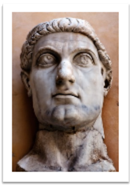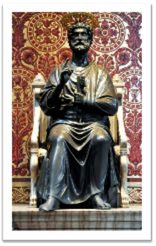
|
|


Constantine was a Roman Emperor from 306 to 337 A.D. 183He was acknowledged as a Roman God (as were all Roman emperors) 184
Constantine was a lifelong pagan that held the title “Pontifex Maximus” which literally means “High Priest”. He was a high priest of the pagan sun gods. 185
Decades ago Emperor Diocletian had divided the Roman Empire. This resulted in a series of conflicts between the co-emperors of the Roman Empire. 186
The night before the battle of Milvian Bridge (against Emperor Maxentius), Constantine had allegedly seen a vision from the ‘Christian God’ while was marching with his army. He looked up to the sun and saw a cross of light above with the greek words "Εν Τούτῳ Νίκα" translated “Through this sign you shall conquer”. 183, 187
The following night he allegedly had a dream in which Jesus Christ appeared to him with the same sign and commanded and explained to him that the cross should the sign against his enemies. Constantine summoned his goldsmiths and workers in precious stones to build a Labarum with the sign he saw (“Chi-Rho” symbol, looks like the letters XP put together). He ordered the painting of this sign on the shields of his soldiers. He later on went on and won the battle against his enemies. 183
|
|

The Roman Empire was under threat by the division of the empire, internal and religious discord, outward pressure of the barbarians (people who did not belong to the great civilisations; Greek, Roman, Christian). The great Spirit/power of Rome was fast departing. Christianity seemed like the only efficient power for a political reformation of the Empire. 188
Idolatry also had outlived itself in the Roman Empire, Christianity could breathe new life into it, as the Christians were following already pagan traditions instituted by Saint Paul. 188
Prior to this, Christians were persecuted under the Roman Empire for centuries. Constantine stopped the persecution of the Christians and improved the condition of slaves. Even though he was promoting Christianity, he himself wasn’t practising it. 188
Historian J L Mosheim states "The Christian bishops introduced, with but slight alterations, into the Christian worship, those rites and institutions by which formerly the Greeks and Romans and others had manifested their piety and reverence toward their imaginary deities; supposing that the people would more readily embrace Christianity if they perceived the rites handed down to them from their fathers still existing unchanged among the Christians, and saw that Christ and the martyrs were worshipped in the same manner as formerly their gods were.” 189
Pagan statues (of gods) were re-labelled. Isis and Horus became Mary and Jesus. 190 Statues of Jupiter were re-labelled to Saint Peter. Just like the one in the Vatican where millions of visitors touch and kiss its feet. 191 You can tell it is a sun god by the sun disk behind its head.
Romulus and Remus re-labelled to the great martyrs Cosmas and Damian. 192 Hermes becomes Christ the good shepherd. 158
| A Chronology of some of the Catholic Church heresies | <<< Prev | Next >>> | The Council of Nicea |
